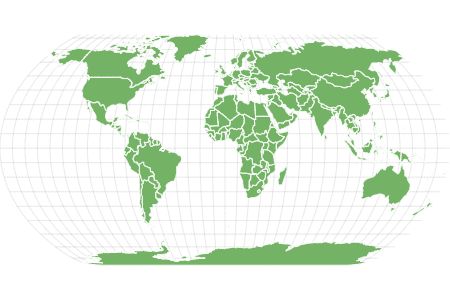Coral
There are more than 6000 species of coral in the world's oceans.
Advertisement
Coral Scientific Classification
Read our Complete Guide to Classification of Animals.
Coral Conservation Status
Coral Facts
- Main Prey
- zooplankton
- Fun Fact
- There are more than 6000 species of coral in the world's oceans.
- Distinctive Feature
- Variety of colours and full of holes for species to hind in
- Habitat
- Tropical Oceans
- Predators
- fish, barnacles, snails, crabs, starfish, marine worms and other sea creatures
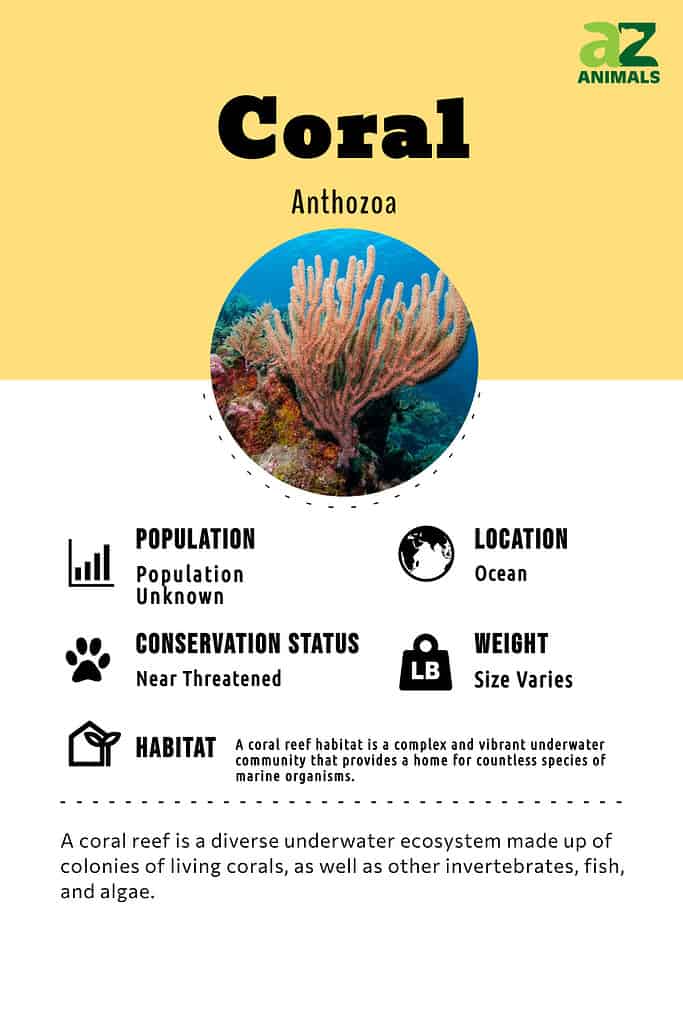
“There are more than 6000 species of coral in the world’s oceans.”
Corals look much like plants but are actually saltwater-dwelling invertebrate marine organisms. They have external or internal skeletons classified as stony-hard, horny, or soft. Of the 6000 or more species in the world today, about 3000 are stony corals. Another 1200 are horny gorgonians and about 800 are soft corals.
Coral animals are made up of a central polyp with a skeleton growing around it. Each individual coral polyp body is shaped like a tube with one end attaching itself to a hard surface, rooting where it will stay for the rest of its life. These hard surfaces can include rocks, the ocean floor, or debris like shipwrecks.
Multiple polyps of some types of coral form immobile colonies with many bodies working together for survival and reproduction. These colonies in turn make up carpets of polyps called reefs. Other types of coral grow individually like mushrooms in a wide range of sizes.
5 Incredible Coral Facts!
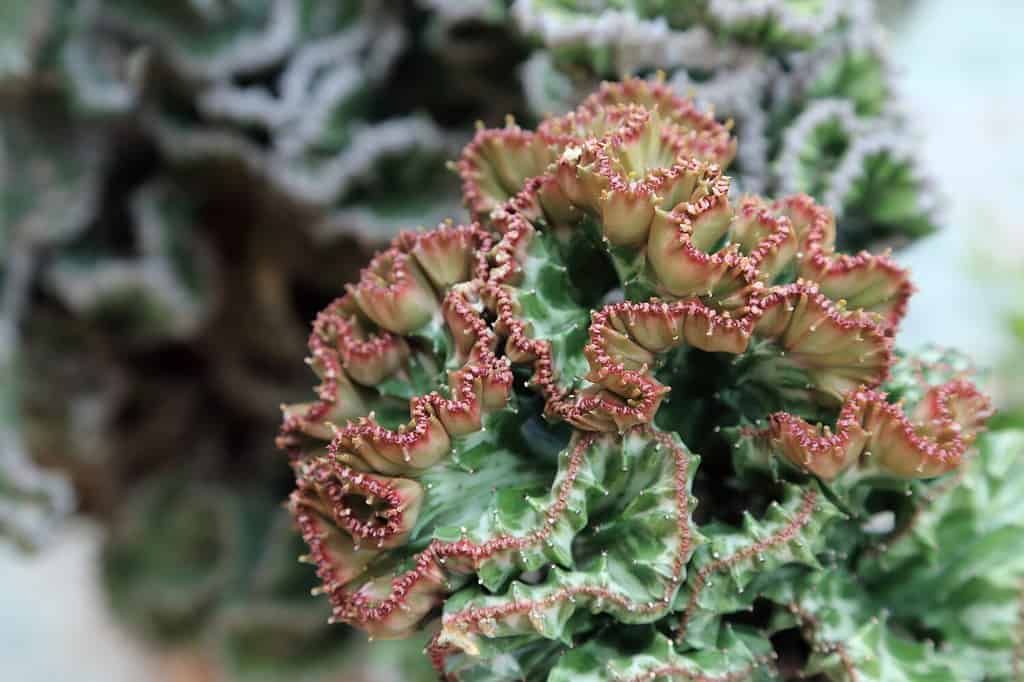
©enrouteksm/Shutterstock.com
- Coral are animals that look like plants growing on the ocean floor and other hard surfaces
- They are among the slowest-growing creatures on the planet.
- Reefs create underwater ecosystems for a wide variety of plant and animal life.
- These animals filter the ocean’s water and help keep it clean.
- The Great Barrier Reef, a coral reef in Australia, is so large that it is visible from outer space.
Read more interesting facts about corals here.
Scientific Name
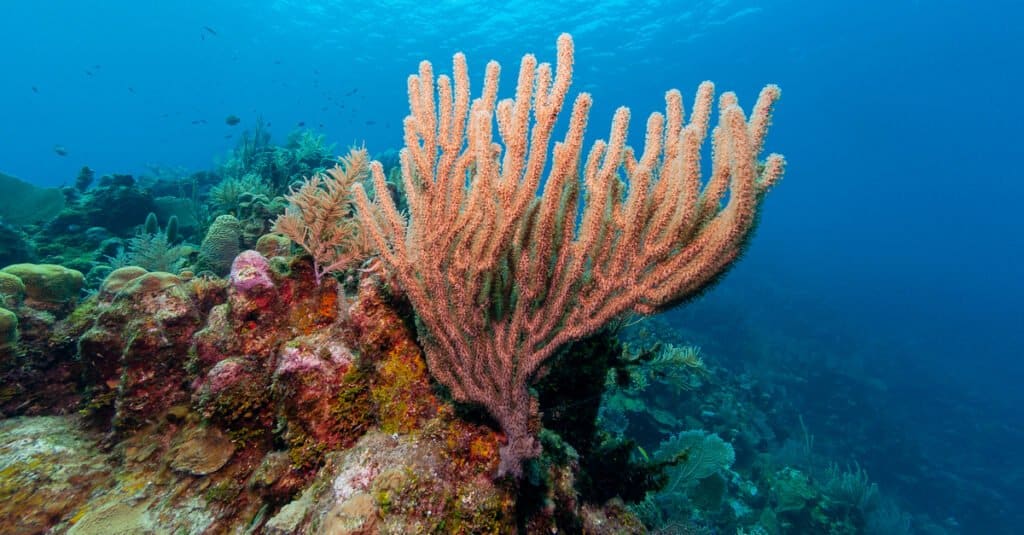
Coral kills its prey by using the nematocysts, or venomous thread, on their tentacles.
©Jesus Cobaleda/Shutterstock.com
Coral has discovered hundreds of years ago but has been long misunderstood. In fact, scientists believed them to be minerals or plants until the 18th century. It was at that time that William Herschel viewed some of these organisms under a microscope, finding that they had the cell structures of animals.
The name “coral” is a French term widely used since the 11th century when a commentator named Rashi called the plant-like creatures a “tree that grows underwater.”
Evolution and Origins
Coral reefs originated during the Cambrian period, roughly 535 million years ago, although it’s difficult to find fossils from this time. However, during the Ordovician period, which was approximately 100 million years later, there was an abundance of fossils from widespread Heliolitida, rugose, and tabulate corals. In the Paleozoic era, these corals frequently had numerous symbiotic organisms living within them.
It can be inferred that scleractinian corals, which rely on symbionts, likely descended from soft-bodied ancestors that existed during the Paleozoic era. Present-day Scleractinia that live in shallow waters and depend on symbiotic relationships seem to have originated separately from non-symbiotic, solitary predecessors.
Corals, which were first seen as single entities in fossils over 400 million years ago, are incredibly old creatures that transformed into modern forms capable of constructing reefs in the last 25 million years. These coral reefs are exceptional structures (for example, they’re the largest biological structures on earth) and complex systems.
Different Types
Here are list of coral species and animal species that need coral reefs to survive:
- Staghorn coral
- Elkhorn coral
- Galaxea fascicularis
- Organ pipe coral
- Open brain coral
- Porites porites
- Plerogyra sinuosa
- Nemenzophyllia turbida
- Agaricia tenuifolia
- Stichodactyla haddoni
- Heteractis magnifica
- Condylactis gigantea
- Bubble-tip anemone
- Red lionfish
- Agaricia agaricites
- Caribbean reef shark
- Acropora clathrata
- Lophelia pertusa
- Orange cup coral
- Acropora tenuis
- Porites lutea
- Dipsastraea speciosa
- Acropora millepora
- Alcyonium glomeratum
- Eusmilia
- Blue tang
- Montastraea cavernosa
- Leaf plate montipora
- Blue ring angelfish
- Montipora digitata
- Gorgonia flabellum
- Siderastrea siderea
- Stylophora pistillata
- Diploastrea heliopora
- Octopus cyanea
- Orbicella franksi
- Grey reef shark
- Yellow-edged moray
- Bigeye trevally
- Variegated lizardfish
- Blacktip Reef Shark
- Common bluestripe snapper
- Banded pipefish
- Yellow tang
- Moorish idol
- Moon jelly
- Harlequin tuskfish
- Bartlett’s anthias
- Mandarinfish
- Hymenocera picta
- Pillar coral
Appearance and Behavior
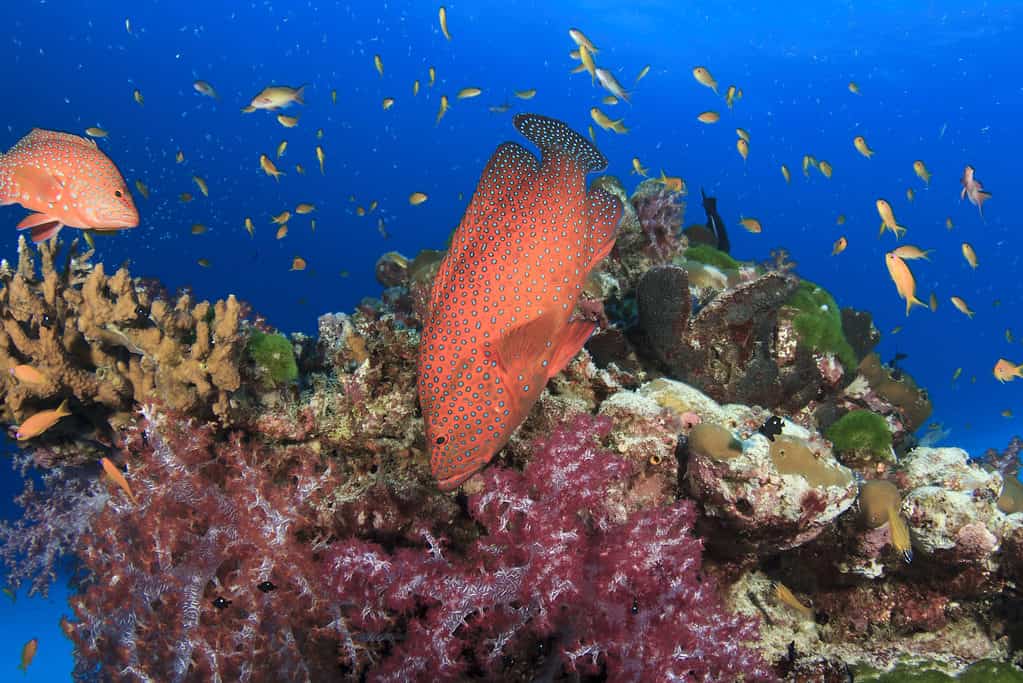
red grouper coral reef
©Rich Carey/Shutterstock.com
The primary types of coral are soft, horny, and hard. But within these types are more than 6000 species categorized as Octocorallia and Hexacorallia. The soft and horny corals are Octocorallia. The hard coral is Hexacorallia.
Coral behavior is limited because they are sessile creatures, never moving from one spot. In this one location, they live their lives with activity limited to survival and reproduction.
Soft and Horny Coral
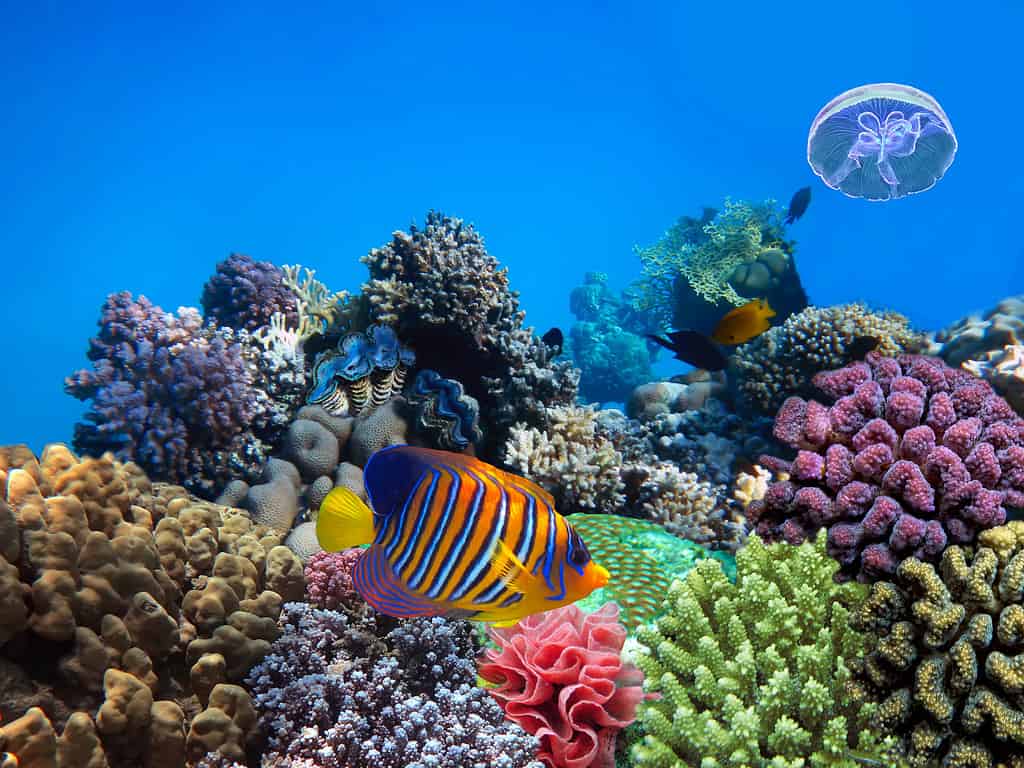
Soft and hard corals in the Red Sea
©iStock.com/vlad61
Octocorallia coral grows in colonies, looking much like plants or tiny trees. Each polyp has eight tentacles that move in the water like feathers. In the center of the polyp is a digestive cavity divided into eight sections. Six of these sections take water in through the action of tiny hair-like cilia. The two remaining sections do not have cilia and push water out of the polyp, and back into the surrounding water.
Octocorallia has internal skeletons surrounded by a fleshy rind. These skeletons are different shapes according to the type of coral. Soft coral has needlelike skeleton structures with a woody consistency. Others have skeleton-like plates.
Still, other soft corals have the shape of fingers, thanks to their finger-like skeletal structure. Horny corals look very different from soft corals, featuring skeletons shaped like ribbons or branches that can extend for up to 10 feet long. Blue coral grows in lumps up to 6.5 feet in diameter.
Soft coral can feature a wide range of colors, from whites, pinks, and reds to purples, blues, and yellows.
Stony Hard Coral
Stony hard corals also have eight inner chambers in the polyps. But they have simple tentacles, not the feather-like ones of the Octocorallia. Stony, black, and thorny corals of the Hexacorallia order also have external skeletons and can live in shallow tidal areas or up to 20,000 feet under the waves. Some of these corals are solitary and others make up colonies. Colonial polyps measure from 0.04 inches to 1.2 inches in diameter.
The solitary forms of this stony hard order grow to a diameter of up to 10 inches, just about the size of a dinner plate. Despite having white skeletons, these corals can vary widely in color. Stony corals are typically colored according to the algae living on them, from yellow or brown to olive greens.

©iStock.com/atese
Habitat
Coral lives in oceans around the world, primarily in waters from 68 to 90 degrees Fahrenheit. These animals require a specific ratio of salt to water to survive. This means they cannot live in freshwater or where rivers drain into the ocean. They also do not live in lakes with higher salinity than the ocean, such as the Great Salt Lake of Utah.
Besides the right amount of salt in the water and a stable temperature range, coral has other needs from their habitat. These include direct sunlight, needing the sun’s rays to cut through the water to feed the algae that, in turn, provides oxygen for the coral. This means that most species live at depths of less than 165 feet. For the sun to penetrate the water, the water must also be clear and not clouded by plankton or sediment. Coral polyps are also highly sensitive to pollution, climate change, and disruption by humans.
Coral reefs are vital to human survival even though they only live on about one percent of the ocean floor. These animals have existed for 500 million years, serving the distinct purpose of sheltering and feeding about 25% of marine life.
They also help filter the oceans to keep this habitat healthy for fish and other species, prevent coastal erosion, and provide a buffer from storm surges. Because of these roles they play, coral reefs are worth about $30 billion per year to the human economy.
Diet
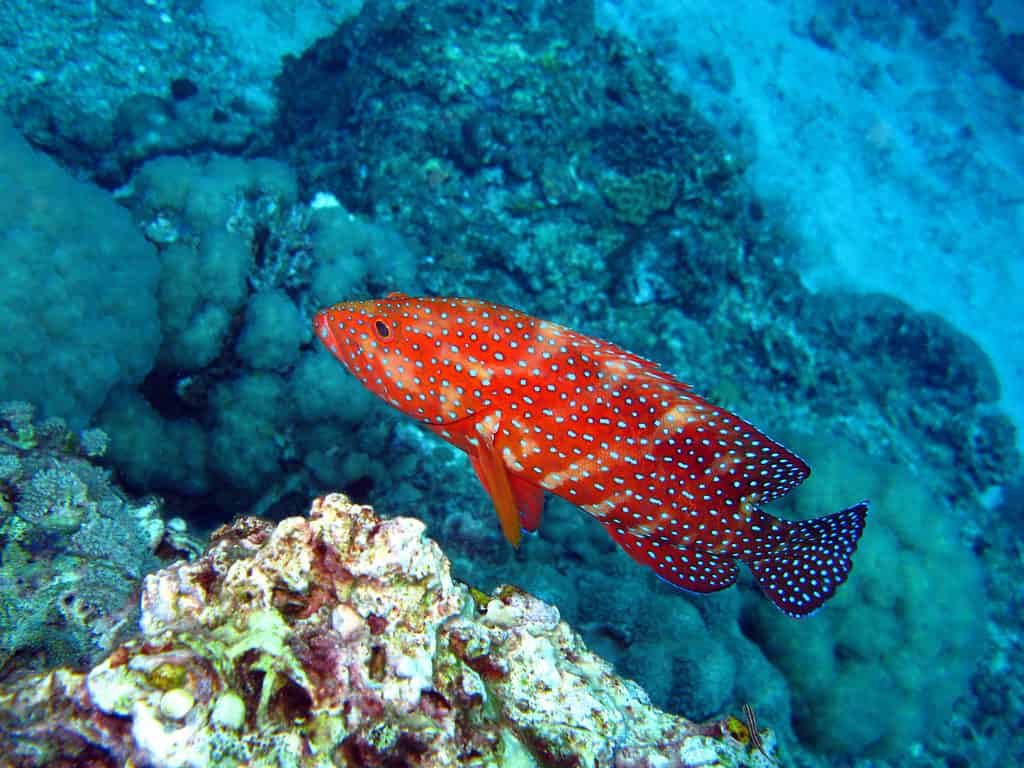
Coral trouts are hermaphrodites–they can change genders when external circumstances require it.
©DiveSpin.Com/Shutterstock.com
Coral receives their energy from tiny algae called zooxanthellae. This alga lives inside the coral’s polyps where it uses sunlight and the process of photosynthesis to make sugar. The coral polyp receives this sugar energy made by the algae. At the same time, the algae provide oxygen for the coral. The animal releases carbon dioxide during respiration, providing this to the plant living within it.
Besides receiving energy and oxygen from algae, coral also feeds on zooplankton. These are tiny creatures floating in the ocean’s currents. Using their long tentacles, coral reaches out to the water around them, catching the zooplankton as it floats past. The tentacles sting the creatures that are then pulled into the coral polyp’s mouth for digestion.
Unfortunately, many sea creatures consider coral a tasty treat. The inner, fleshy polyps are eaten by fish, barnacles, snails, crabs, starfish, and marine worms.
Predators and Threats
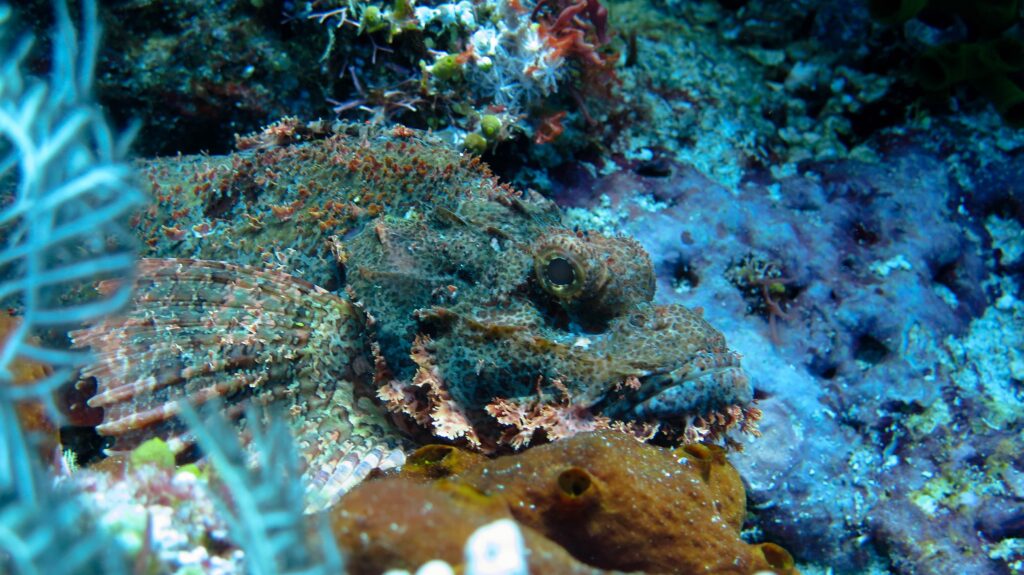
Tasseled Scorpionfish are extremely well camouflaged and blend in with the coral reefs and the rocky bottom of the sea.
©asharibare/Shutterstock.com
Some of the biggest threats to coral are the weather, tides, UV rays of the sun, high temperatures, and pollution. All of these threats relate to climate change.
Coral reefs frequently suffer damage from major weather events like hurricanes and cyclones. These storms break and flatten the animals’ colonies. Low tides also leave them exposed to direct sunlight which can overheat and dehydrate coral.
They are also threatened by other marine life that feeds on them. Coral is often part of the diets of fish, barnacles, snails, crabs, starfish, marine worms, and other sea creatures. Humans are one of their biggest threats, because of commercial fishing activities, climate change, and direct, damaging contact with coral reefs.
In stressful conditions, coral can expel the algae that grow within their polyps and provides them with oxygen, the zooxanthellae. As a result of this action, the coral bleaches and often die.
Since coral plays a major role in the ocean’s habitat and for humans, there are many organizations working to save coral reefs. Of over 6000 types of coral, two are currently considered critically endangered and possibly extinct. These include Wellington’s solitary coral of Ecuador and Millepora boschmai of Panama. After major storms hit Ecuador, it is believed there are only two colonies of Wellington’s solitary coral remaining. The IUCN reports that about one-third of the reef, corals are facing extinction from climate change.
Reproduction, Babies, and Lifespan
Each of the unique species of coral has its own reproductive methods. Some are hermaphrodites, like star corals and brain corals. This means one animal reproduces on its own without needing a mate, producing all of its own sperm and eggs. Other types produce colonies of only one sex, being gonochoric. Examples of gonochoric corals include boulders and elkhorn. These corals either produce solely sperm or eggs.
For reproduction, the coral forms larvae by either fertilizing within its polyp or in the water outside of the polyp. To fertilize an egg within a polyp, sperm is released by another polyp into the egg holder’s mouth. The mother polyp holds the merged sperm and egg in its body where they form a larva and mature. Upon maturity, the larva is released into the water.
To fertilize an egg in the water, some species release large numbers of eggs. Nearby polyps release large quantities of sperm into the water for a process of fertilization called coral spawning. For many types of coral, this event happens only one night per year.
Coral larvae naturally move toward the light. They swim to the water’s surface and stay there for as long as weeks. Larvae that survive eventually make their way back to the floor of the ocean where they root to a hard surface. Once attached, the larva transforms into a coral polyp and starts cloning itself to create more polyps for a colony.
Some species of coral can live for more than 4,000 years. The lifespan depends on many factors such as species. Coral polyps essentially clone themselves to form colonies, so there is much debate among scientists about how to determine age.
Population
Coral reefs are found in more than 100 countries and on one percent of the ocean’s floor. Populations of these animals are most threatened by climate change and related factors like pollution. While scientists agree that most coral reefs and species are threatened, there are more than 6000 species to track. Most of these species that have been researched are listed as being in decline.
Zoo and Aquariums
Zoos and public aquariums play a major role in coral research and conservation. Some of the most noteworthy zoos and aquariums with coral reefs in the United States include:
- Audubon Aquarium of the Americas in New Orleans, Louisiana
- Florida Aquarium in Tampa, Florida
- Shedd Aquarium in Chicago, Illinois
- Vancouver Aquarium in Vancouver, British Columbia
- Fort Worth Zoo in Fort Worth, Texas
Some aquariums and zoos have free live feeds available for anyone to watch their coral reefs from a computer or smartphone. These aquariums include:
- Aquarium of the Pacific in Long Beach, California
- Georgia Aquarium in Atlanta, Georgia
- Monterey Bay Aquarium in Monterey, California
- National Aquarium of Baltimore in Baltimore, Maryland
- Tennessee Aquarium in Chattanooga, Tennessee
If seeing coral reefs is not enough for you, you can dive into many of the world’s most colorful coral reefs in tourist destinations like the Florida Keys, Australia, Guatemala, Belize, and South Africa. You can even grow your own coral reef in your home aquarium.
View all 235 animals that start with CCoral FAQs (Frequently Asked Questions)
What Kingdom do Corals belong to?
Corals belong to the Kingdom Animalia.
What phylum do Corals belong to?
Corals belong to the phylum Cnidaria.
What class do Corals belong to?
Corals belong to the class Anthozoa.
In what type of habitat do Corals live?
Corals live in tropical oceans.
What are some distinguishing features of Corals?
Corals are colorful and full of holes for other species to hide in.
What are some predators of Corals?
Predators of Corals include starfish, marine slugs, and snails.
What is the lifespan of a Coral?
Corals can live for 15 to 30 years.
Are coral carnivores, herbivores, or omnivores?
Coral are carnivores. They use their long tentacles with stingers to catch and subdue their prey. They mostly feed on plankton, tiny creatures in the ocean’s water.
What is coral?
Although coral looks like plants growing on the ocean floor, these creatures are actually animals. They have tube-shaped bodies called polyps that root on rocks, the seafloor, shipwrecks, or other hard surfaces. Within these bodies are tissues used for digestion, respiration, and reproduction.
Is coral an animal, plant, or rock?
Coral is a living, breathing saltwater marine animal in the phylum Cnidaria. In fact, coral reefs are made up of colonies of individual animals called polyps. These polyps can vary in appearance widely, particularly in terms of size and colors. They measure from less than a millimeter to up to a foot in diameter. They are also found in every color on the spectrum.
What is coral used for?
Coral serves many purposes in the ocean and for humans. In the ocean, coral helps filter the water and reduce the effects of major storms on land. Coral becomes beautiful jewelry. It is also used for medicines to treat multiple sclerosis, cancer, and heart disease. Surgeons can use coral to regrow human bone.
What are the characteristics of coral?
Coral has many interesting characteristics such as its wide range of colors and sizes. Coral colors include white, yellow, orange, red, blue, green, brown, and purple. These animals can also vary widely in their structure. Some feature the characteristics of a flower, mushroom, or human brain. Others look like plants or trees.
Why are coral reefs important?
Coral reefs are a critical part of marine habitat, providing food and shelter for many species of fish and crustaceans. They also protect our coastlines from erosion. These animals provide medicine, food, and income for humans, supporting over 500 million people worldwide.
What is coral bleaching?
Coral bleaching is the coral’s reaction to intense stress. With hurricanes, high temperatures, or other major events, for example, the coral will force the algae living in its polyp out of its body. Because algae are largely responsible for the coral’s color, this takes away the animal’s color. But algae also provide oxygen and energy for the coral. As a result, bleaching coral can die.
What color is coral?
With more than 6000 species of coral within the phylum Cnidaria, these animals exist in every color of the rainbow. The most common colors include white, yellow, brown, red, orange, pink, purple, green and blue.
How to say Coral in ...
Thank you for reading! Have some feedback for us? Contact the AZ Animals editorial team.
Sources
- Wikipedia, Available here: https://en.wikipedia.org/wiki/Coral#Taxonomy
- Britannica, Available here: https://www.britannica.com/animal/coral
- Animal World, Available here: https://animal-world.com/aquarium-coral-reefs/soft-coral-facts-and-information
- Marine Insight, Available here: https://www.marineinsight.com/environment/15-amazing-facts-about-coral-reefs/
- Coral Reef Alliance, Available here: https://coral.org/coral-reefs-101/coral-reef-ecology/what-do-coral-reefs-need-to-survive/
- Florida Keys National Marine Sanctuary, Available here: https://floridakeys.noaa.gov/corals/coralseat.html
- NOAA, Available here: https://oceanservice.noaa.gov/education/tutorial_corals/coral08_naturalthreats.html
- Nature, Available here: https://www.nature.com/articles/news.2009.185
- Our World in Data, Available here: https://ourworldindata.org/search?q=coral
- Science Friday, Available here: https://www.sciencefriday.com/videos/how-to-grow-coral/
- Super Reefs, Available here: https://superreefs.whoi.edu/super-coral-zoos/

